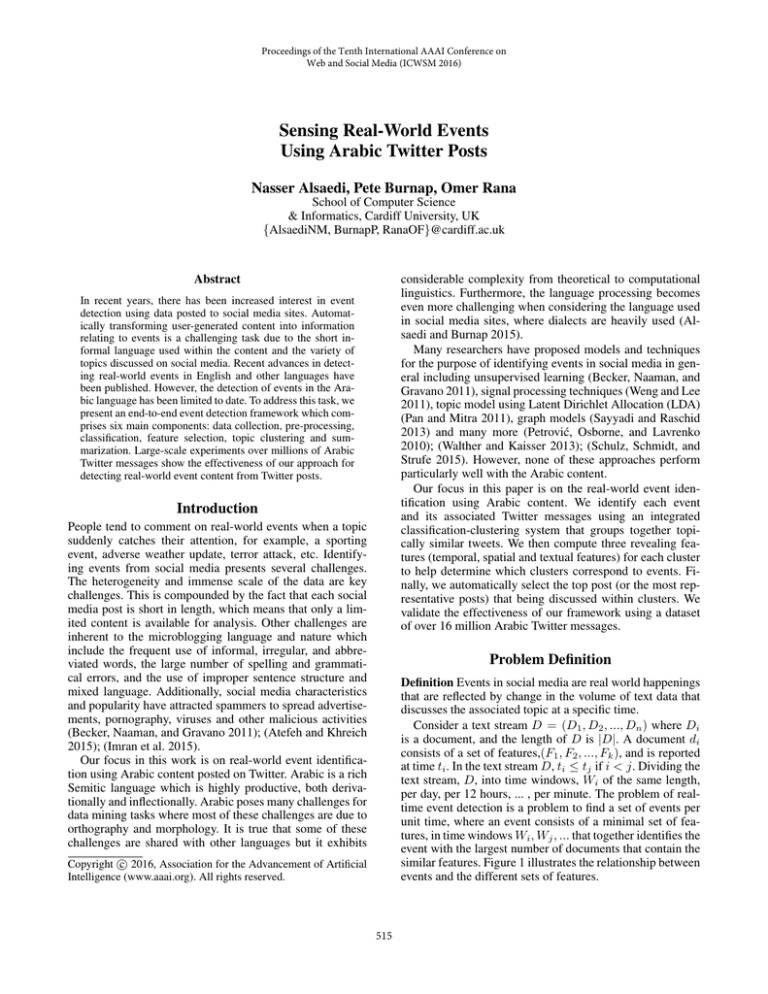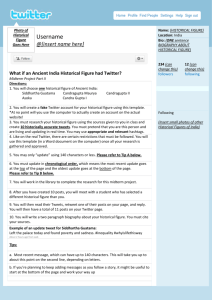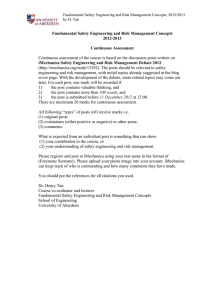
Proceedings of the Tenth International AAAI Conference on
Web and Social Media (ICWSM 2016)
Sensing Real-World Events
Using Arabic Twitter Posts
Nasser Alsaedi, Pete Burnap, Omer Rana
School of Computer Science
& Informatics, Cardiff University, UK
{AlsaediNM, BurnapP, RanaOF}@cardiff.ac.uk
considerable complexity from theoretical to computational
linguistics. Furthermore, the language processing becomes
even more challenging when considering the language used
in social media sites, where dialects are heavily used (Alsaedi and Burnap 2015).
Many researchers have proposed models and techniques
for the purpose of identifying events in social media in general including unsupervised learning (Becker, Naaman, and
Gravano 2011), signal processing techniques (Weng and Lee
2011), topic model using Latent Dirichlet Allocation (LDA)
(Pan and Mitra 2011), graph models (Sayyadi and Raschid
2013) and many more (Petrović, Osborne, and Lavrenko
2010); (Walther and Kaisser 2013); (Schulz, Schmidt, and
Strufe 2015). However, none of these approaches perform
particularly well with the Arabic content.
Our focus in this paper is on the real-world event identification using Arabic content. We identify each event
and its associated Twitter messages using an integrated
classification-clustering system that groups together topically similar tweets. We then compute three revealing features (temporal, spatial and textual features) for each cluster
to help determine which clusters correspond to events. Finally, we automatically select the top post (or the most representative posts) that being discussed within clusters. We
validate the effectiveness of our framework using a dataset
of over 16 million Arabic Twitter messages.
Abstract
In recent years, there has been increased interest in event
detection using data posted to social media sites. Automatically transforming user-generated content into information
relating to events is a challenging task due to the short informal language used within the content and the variety of
topics discussed on social media. Recent advances in detecting real-world events in English and other languages have
been published. However, the detection of events in the Arabic language has been limited to date. To address this task, we
present an end-to-end event detection framework which comprises six main components: data collection, pre-processing,
classification, feature selection, topic clustering and summarization. Large-scale experiments over millions of Arabic
Twitter messages show the effectiveness of our approach for
detecting real-world event content from Twitter posts.
Introduction
People tend to comment on real-world events when a topic
suddenly catches their attention, for example, a sporting
event, adverse weather update, terror attack, etc. Identifying events from social media presents several challenges.
The heterogeneity and immense scale of the data are key
challenges. This is compounded by the fact that each social
media post is short in length, which means that only a limited content is available for analysis. Other challenges are
inherent to the microblogging language and nature which
include the frequent use of informal, irregular, and abbreviated words, the large number of spelling and grammatical errors, and the use of improper sentence structure and
mixed language. Additionally, social media characteristics
and popularity have attracted spammers to spread advertisements, pornography, viruses and other malicious activities
(Becker, Naaman, and Gravano 2011); (Atefeh and Khreich
2015); (Imran et al. 2015).
Our focus in this work is on real-world event identification using Arabic content posted on Twitter. Arabic is a rich
Semitic language which is highly productive, both derivationally and inflectionally. Arabic poses many challenges for
data mining tasks where most of these challenges are due to
orthography and morphology. It is true that some of these
challenges are shared with other languages but it exhibits
Problem Definition
Definition Events in social media are real world happenings
that are reflected by change in the volume of text data that
discusses the associated topic at a specific time.
Consider a text stream D = (D1 , D2 , ..., Dn ) where Di
is a document, and the length of D is |D|. A document di
consists of a set of features,(F1 , F2 , ..., Fk ), and is reported
at time ti . In the text stream D, ti ≤ tj if i < j. Dividing the
text stream, D, into time windows, Wi of the same length,
per day, per 12 hours, ... , per minute. The problem of realtime event detection is a problem to find a set of events per
unit time, where an event consists of a minimal set of features, in time windows Wi , Wj , ... that together identifies the
event with the largest number of documents that contain the
similar features. Figure 1 illustrates the relationship between
events and the different sets of features.
c 2016, Association for the Advancement of Artificial
Copyright Intelligence (www.aaai.org). All rights reserved.
515
post belonging to either class is derived on the basis of the
occurrence of the post’s features in the training data. When a
new example is presented, the class likelihood for the unseen
data is predicted on the basis of the training instances.
Algorithmic steps:
1. Input posts.
2. Extract features from posts.
3. These features and their corresponding labels are used to
train the learning algorithm (Naive Bayes classifier).
4. New posts are presented to the trained classifier to predict
their label according to their extracted features.
Figure 1: Document clustering using various sets of features
Feature Selection
System Design
Different events can be characterized by different set of features: temporal, spatial and textual features. These features
are computed for the Online-Clustering. The temporal features are related to the “speed” of diffusion over time by
highlighting the “quality” of posts created by users in different time frames. The spatial features include Neighbourhood (Local) granularity, City (Intermediate) granularity and
Country (General) level. Textual features consist of many
content representative features such as Near-Duplicate measure, Retweet ratio, Mention ratio, Hashtag ratio, Url ratio,
Text sentiment and Dictionary features. A full description of
these features is given in (Alsaedi, Burnap, and Rana 2015).
As we receive high volume of posts per hour with wide variety of tweets, traditional monitoring is impractical. Our proposed framework is based on collecting a series of data over
time windows for a given location which supports the autoidentification of meaningful events from Twitter.
Data Collection
We collect user-generated updates directly from Twitter
Streaming API as it allows subscription to a continuous live
stream of data. Our goal is to detect events in a given location without prior knowledge of these events. Thus, we
collect tweets based on a set of keywords that describes a region (e.g., Iraq, Syria, Egypt, ...) using Arabic language. We
also collect user updates from users who selectively add the
required region as their location. We also make use of geographic Hashtags in the data collection process (e.g., #Ramadi, #Aleppo, #Cairo, ...). Data are stored temporarily using MongoDB database (www.mongodb.org).
Temporal features Temporal features are important factors that have been considered in many data mining studies including event identification. The volume of posts and
the continually updated commentary around an event suggest that informative posts from several hours ago may not
be as important as new posts (Becker, Naaman, and Gravano
2011). For this reason we retain the most frequently occurring terms in a cluster in hourly time frames and compare
the number of posts published in an hour that contain term t
to the total number of posts published during that hour.
Pre-Processing
The goal of this step is to represent data in a form that can
be analyzed efficiently. We perform text processing techniques such as stop-word elimination (Term frequency and
TF-IDF are the criteria used for classifying stop words) and
stemming (an updated version of Khoja stemmer (Diab, Hacioglu, and Jurafsky 2004)) for Arabic text. To the Arabic
stop word list included in the Khoja stemmer, we added
more stop words which are determined using Term frequencies and the TF-IDF of the training corpus. Moreover, posts
that were less than 5 words long were removed, as were messages where over half the total words were the same word,
since these posts were less likely to have useful information.
Classification
Spatial features (geospatial, regional) Events are characterized by a rich set of spatial and demographic features. We make use of three statistical location approaches;
the first one is from Twitter itself where the source latitude and longitude coordinates are extracted (if provided
by the user). The second method depends on shared media (photos and videos) by using the GPS coordination
of the capture device (if supported). Third, OpenNLP
(http://opennlp.sourceforge.net) and Named-Entity Recognition (NER) are implemented for geotagging the tweet content (text) to identify places, street names, landmarks, etc.
This step aims to distinguish events from noise or irrelevant
posts. The early classification dramatically reduces the number of posts to be processed in the following steps because
these steps will process only event-related updates. Words
from each status are considered as features and Naive Bayes
classifier was chosen for the classification task.
The features and their corresponding category (event or
non-event) were provided to the classifier, constituting the
training set. From the training data the likelihood of each
Textual features Textual or content features have been
identified as contributing to the spread of a post in the social
media. Most of these features have been widely addressed
in the data mining literature including; Near-Duplicate measure (Walther and Kaisser 2013), Retweet ratio (Becker,
Naaman, and Gravano 2011), Mention ratio (Becker, Naaman, and Gravano 2011), Hashtag ratio (Imran et al. 2015),
Link or Url ratio (Atefeh and Khreich 2015), Text sentiment
(Imran et al. 2015), Dictionary-based feature (Walther and
516
Kaisser 2013). The dictionary-based feature uses a dictionary of trigger words such as present tense verbs, popular
event nouns and adjectives to characterize real-time events.
considers a set of tweets in a cluster for each timeframe to
be represented as a document. The total number of clusters
equals the total number of documents which is a sub-set of
the entire dataset. This reduces the overall computational
complexity and overcomes the limitations of the TF-IDF
based approaches. We define the temporal TF-IDF weighting scheme of a new document d for a collection C as:
Online-Clustering
The classification step separates event-related tweets from
non-event posts such as chats, personal updates, etc. Nonevent posts are filtered. To identify the topic of an event, we
define temporal, spatial and textual set of features, which
are detailed in the previous section. We then apply an online
clustering algorithm, which is outlined in Algorithm 1.
Using a set of features (F1 , ..., Fk ) for each document
(D1 , ..., Dn ) we compute the cosine similarity measure between the document and each cluster (C1 , ..., Ck ) where the
similarity function is computed against each cluster cj in
turn for j = 1, . . . , m and m is the number of clusters (initially m = 0). We use the average weight of each term
across all documents in the cluster to calculate the centroid
similarity function E(Di , cj ) of a cluster. The threshold parameters are determined empirically in the training phase.
wji =
1
N
)
fji × log(1 +
norm(di )
Nj
(1)
where fji is the term frequency of word in document di
and Nj is document frequency of word in a collection and
N is the total number of documents in the collection. Therefore, this summarizer selects the most weighted post as summary as determined by the Temporal TF-IDF weighting.
Experiments
Experimental Settings
Dataset: Our dataset consists of over 16 million Arabic
tweets (16,101,284) and was collected from 1 October 2015
until 30 November 2015 using Twitter’s Streaming API.
Since we are interested in identifying events in Arabic language, we limited ourselves to tweets published in Arabicspeaking countries.
Annotations: We use human annotators to label classes
for classification and clusters for the online clustering (training and testing phases). For complete details of our annotation guidelines, please refer to (Alsaedi and Burnap 2015).
(a) Classification: From our collected data, three annotators manually labelled 5000 Arabic tweets in to two classes
“Event” and “Non-Event” to train our Naive Bayes Classifier. Event instances outnumbered the non-event ones as the
training set consisted of 1900 Non-Event tweets and 3100
event-related posts. Agreement between our three annotators, measured using Cohen’s kappa coefficient, was substantial (kappa = 0.825). A ten-fold cross validation approach was used to train and test the Classifier.
(b) Clustering: We use the data collected in October for
training and report our results on test data from November.
For the training set, we employed three human annotators to
manually label 800 clusters, randomly selected from the top20 fastest-growing clusters according to hourly message volume at the end of each hour in October 2015. Similarly for
the testing set, three human annotators labelled 800 clusters,
randomly selected from the top-20 fastest-growing clusters
according to hourly message volume at the end of each hour
in November 2015. The agreement between annotators was
calculated using Cohen’s kappa (kappa = 0.791), which indicates an acceptable level of agreement.
Evaluation To evaluate the performance of the event
identification task, we implement two well-known information retrieval metrics, namely, P recision@K and NDCG.
P recision@K reports the fraction of correctly identified
events out of the top-K selected clusters, averaged over all
hours. Where as the normalized discounted cumulative gain
NDCG metric ranks the top events relative to their ideal
ranking as well as NDCG supports graded judgments and
rewards relevant documents in the top ranked list.
Algorithm 1: Online Clustering Algorithm
Input : n set of documents (D1 , ..., Dn )
Threshold τ
Output: k clusters (C1 , ..., Ck )
while τ is given do
compute the centroid similarity function E (Di , cj )
of each cluster cj ;
if centroid similarity E (Di , cj ) ≥ τ then
1) A new cluster is formed containing Di ;
2) The new centroid value = Di ;
else
1) Assign it to the cluster which gives the
maximum value of E (Di , cj ) ;
2) Add Di to cluster j and recalculate the new
centroid value cj ;
end
end
Summarization
After grouping documents (tweets) into different clusters,
the next natural step is to automatically summarize and represent topics being discussed in these clusters. Each cluster
may contain hundreds of posts, images or videos, and the
task of finding the most representative update would indubitably save the decision maker’s time and effort.
The temporal Term Frequency - Inverse Document Frequency (TF-IDF) we propose here generates a summary of
top terms without the need of prior knowledge of the entire
dataset unlike popular TF-IDF approach (Salton and Buckley 1988) and its variants. The temporal TF-IDF is based
on the assumption that words which occur more frequently
across documents over a particular interval (timeframe) have
a higher probability of being selected for human created
multi-document summaries than words that occur less frequently (Salton and Buckley 1988). The temporal TF-IDF
517
mance with short time windows as many of the small clusters are filtered out since they do not exceed the predefined
thresholds and are considered non-relevant events (noise).
This eliminates many of them together with noise, which
confuses the scoring and ranking of event detection.
Conclusion
In this paper we have presented an integrated framework for
detecting real-world events reported in Arabic on Twitter.
The event identification was performed in several stages:
data collection, preprocessing, classification, feature selection, clustering and summarization. Our experiments suggest that our framework yields better performance than
many leading approaches in the real-time event detection.
This work can be used in event management, intelligence
gathering and decision-making including understanding and
tracking terrorist groups, such as Al-Qaeda and ISIS. In future work, we aim to investigate more features, such as network features and rank these features. The detection of rumors in Arabic microblogs will also be considered.
Figure 2: P recision@K for event identification methods.
References
Alsaedi, N., and Burnap, P. 2015. Arabic event detection in
social media. In CICLing’15, 384–401.
Alsaedi, N.; Burnap, P.; and Rana, O. 2015. Identifying
disruptive events from social media to enhance situational
awareness. In IEEE/ACM International Conference on Advances in Social Networks Analysis and Mining (ASONAM).
Atefeh, F., and Khreich, W. 2015. A survey of techniques
for event detection in twitter. Comp. Int. 31(1):132–164.
Becker, H.; Naaman, M.; and Gravano, L. 2011. Beyond
trending topics: Real-world event identification on twitter.
In ICWSM’11.
Diab, M.; Hacioglu, K.; and Jurafsky, D. 2004. Automatic
tagging of arabic text: From raw text to base phrase chunks.
In NAACL’04.
Imran, M.; Castillo, C.; Diaz, F.; and Vieweg, S. 2015. Processing social media messages in mass emergency: A survey. ACM Computing Surveys 47(4):1–67.
Pan, C., and Mitra, P. 2011. Event detection with spatial
latent dirichlet allocation. In JCDL’11.
Petrović, S.; Osborne, M.; and Lavrenko, V. 2010. Streaming first story detection with application. In NAACL’10.
Salton, G., and Buckley, C. 1988. Term-weighting approaches in automatic text retrieval. Information Processing
and Management 24(5):513–523.
Sayyadi, H., and Raschid, L. 2013. A graph analytical approach for topic detection. ACM Transactions on Internet
Technology 13(2):4:1–4:23.
Schulz, A.; Schmidt, B.; and Strufe, T. 2015. Small-scale
incident detection based on microposts. In HT’15.
Walther, M., and Kaisser, M. 2013. Geo-spatial event detection in the twitter stream. In ECIR’13.
Weng, J., and Lee, B. 2011. Event detection in twitter. In
ICWSM’11.
Figure 3: NDCG at K for three event identification methods.
Experimental Results
We compare the output of our framework over strong
methods (Spatial LDA (Pan and Mitra 2011) and unsupervised [Becker et al.2011] method) using P recision@K and
NDCG measures. Figures 2 and 3 show the results of various
event identification methods using our test corpus.
According to Figures 2 and 3, our proposed framework
is effective and outperforms other approaches both in the
NDCG and P recision@K evaluation measures. In fact our
framework discovers much more real-world events than
other approaches such as the refugee crisis, disasters and terrorist attacks (e.g. Paris attacks, Beirut bombings, etc.), war
against ISIS as well as many other events and stories.
In general, Latent Dirichlet Allocation (LDA) is known to
achieve promising results in modeling text collections such
as news articles. However, it fails to achieve such results in
our case due to the fact that tweets are short and a collection
of tweets per hour may contain many more topics than in
news articles. This explains why the (Pan and Mitra 2011)
approach performance is worse than the results reported in
this paper. In addition, the poor performance of (Becker,
Naaman, and Gravano 2011) model has reasonable explanations; first the summarization method performs poorly with
a morphologically rich language such as Arabic. Secondly,
classification after clustering has a crucial impact on perfor-
518






